Himan Abdollahpouri
Long-term Off-Policy Evaluation and Learning
Apr 24, 2024Abstract:Short- and long-term outcomes of an algorithm often differ, with damaging downstream effects. A known example is a click-bait algorithm, which may increase short-term clicks but damage long-term user engagement. A possible solution to estimate the long-term outcome is to run an online experiment or A/B test for the potential algorithms, but it takes months or even longer to observe the long-term outcomes of interest, making the algorithm selection process unacceptably slow. This work thus studies the problem of feasibly yet accurately estimating the long-term outcome of an algorithm using only historical and short-term experiment data. Existing approaches to this problem either need a restrictive assumption about the short-term outcomes called surrogacy or cannot effectively use short-term outcomes, which is inefficient. Therefore, we propose a new framework called Long-term Off-Policy Evaluation (LOPE), which is based on reward function decomposition. LOPE works under a more relaxed assumption than surrogacy and effectively leverages short-term rewards to substantially reduce the variance. Synthetic experiments show that LOPE outperforms existing approaches particularly when surrogacy is severely violated and the long-term reward is noisy. In addition, real-world experiments on large-scale A/B test data collected on a music streaming platform show that LOPE can estimate the long-term outcome of actual algorithms more accurately than existing feasible methods.
Unbiased Cascade Bandits: Mitigating Exposure Bias in Online Learning to Rank Recommendation
Aug 07, 2021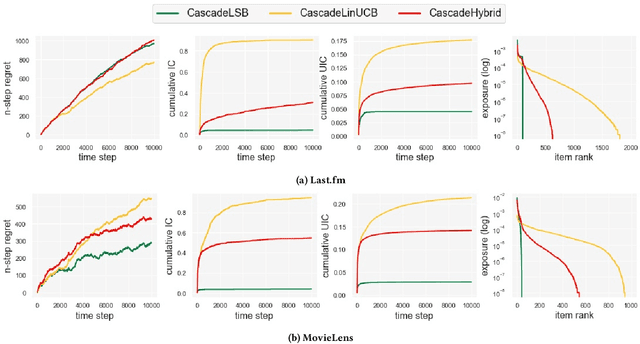

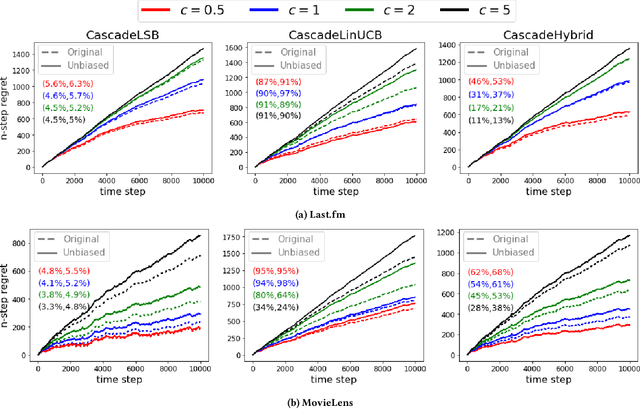
Abstract:Exposure bias is a well-known issue in recommender systems where items and suppliers are not equally represented in the recommendation results. This is especially problematic when bias is amplified over time as a few popular items are repeatedly over-represented in recommendation lists. This phenomenon can be viewed as a recommendation feedback loop: the system repeatedly recommends certain items at different time points and interactions of users with those items will amplify bias towards those items over time. This issue has been extensively studied in the literature on model-based or neighborhood-based recommendation algorithms, but less work has been done on online recommendation models such as those based on multi-armed Bandit algorithms. In this paper, we study exposure bias in a class of well-known bandit algorithms known as Linear Cascade Bandits. We analyze these algorithms on their ability to handle exposure bias and provide a fair representation for items and suppliers in the recommendation results. Our analysis reveals that these algorithms fail to treat items and suppliers fairly and do not sufficiently explore the item space for each user. To mitigate this bias, we propose a discounting factor and incorporate it into these algorithms that controls the exposure of items at each time step. To show the effectiveness of the proposed discounting factor on mitigating exposure bias, we perform experiments on two datasets using three cascading bandit algorithms and our experimental results show that the proposed method improves the exposure fairness for items and suppliers.
A Graph-based Approach for Mitigating Multi-sided Exposure Bias in Recommender Systems
Jul 07, 2021
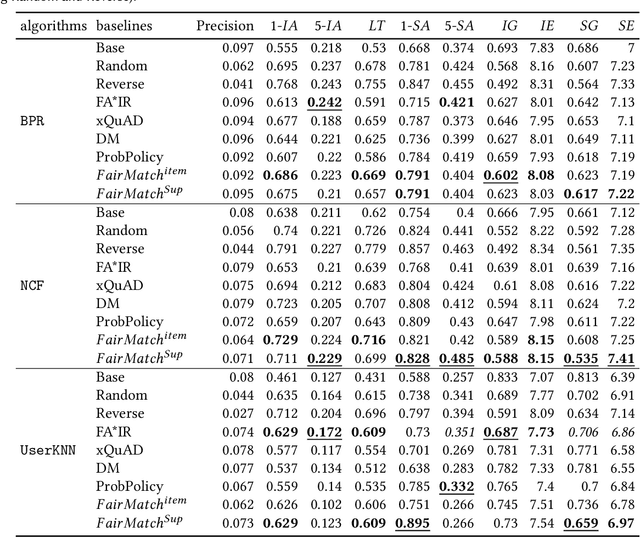

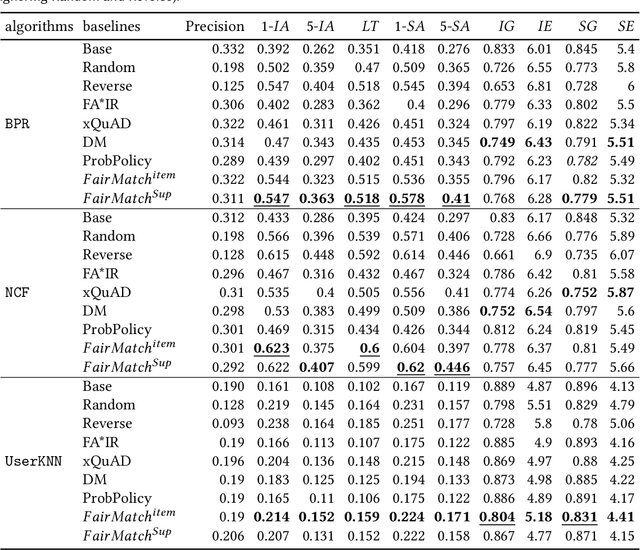
Abstract:Fairness is a critical system-level objective in recommender systems that has been the subject of extensive recent research. A specific form of fairness is supplier exposure fairness where the objective is to ensure equitable coverage of items across all suppliers in recommendations provided to users. This is especially important in multistakeholder recommendation scenarios where it may be important to optimize utilities not just for the end-user, but also for other stakeholders such as item sellers or producers who desire a fair representation of their items. This type of supplier fairness is sometimes accomplished by attempting to increasing aggregate diversity in order to mitigate popularity bias and to improve the coverage of long-tail items in recommendations. In this paper, we introduce FairMatch, a general graph-based algorithm that works as a post processing approach after recommendation generation to improve exposure fairness for items and suppliers. The algorithm iteratively adds high quality items that have low visibility or items from suppliers with low exposure to the users' final recommendation lists. A comprehensive set of experiments on two datasets and comparison with state-of-the-art baselines show that FairMatch, while significantly improves exposure fairness and aggregate diversity, maintains an acceptable level of relevance of the recommendations.
Toward the Next Generation of News Recommender Systems
Mar 11, 2021
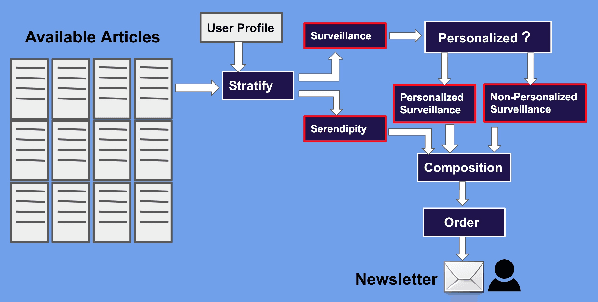
Abstract:This paper proposes a vision and research agenda for the next generation of news recommender systems (RS), called the table d'hote approach. A table d'hote (translates as host's table) meal is a sequence of courses that create a balanced and enjoyable dining experience for a guest. Likewise, we believe news RS should strive to create a similar experience for the users by satisfying the news-diet needs of a user. While extant news RS considers criteria such as diversity and serendipity, and RS bundles have been studied for other contexts such as tourism, table d'hote goes further by ensuring the recommended articles satisfy a diverse set of user needs in the right proportions and in a specific order. In table d'hote, available articles need to be stratified based on the different ways that news can create value for the reader, building from theories and empirical research in journalism and user engagement. Using theories and empirical research from communication on the uses and gratifications (U&G) consumers derive from media, we define two main strata in a table d'hote news RS, each with its own substrata: 1) surveillance, which consists of information the user needs to know, and 2) serendipity, which are the articles offering unexpected surprises. The diversity of the articles according to the defined strata and the order of the articles within the list of recommendations are also two important aspects of the table d'hote in order to give the users the most effective reading experience. We propose our vision, link it to the existing concepts in the RS literature, and identify challenges for future research.
User-centered Evaluation of Popularity Bias in Recommender Systems
Mar 10, 2021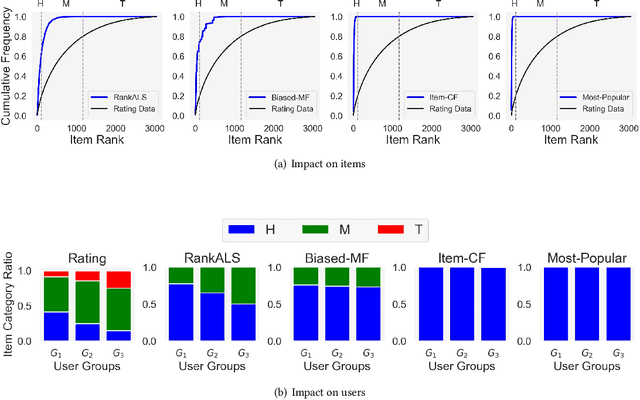
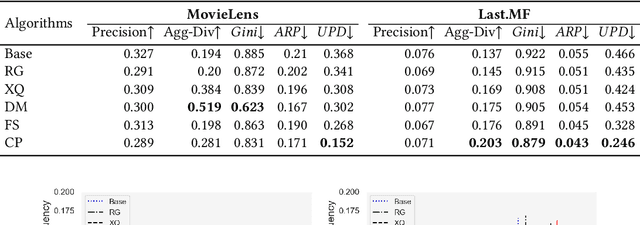
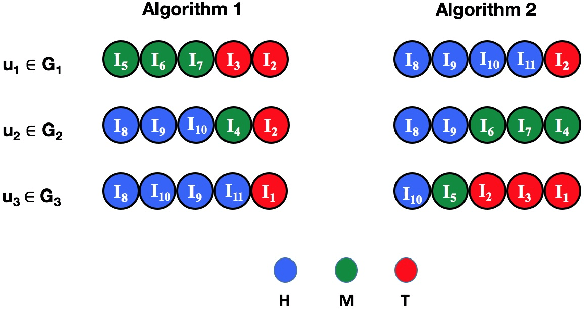
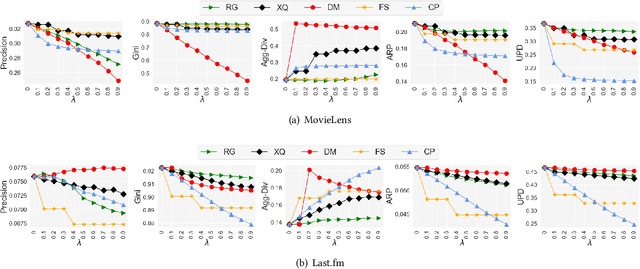
Abstract:Recommendation and ranking systems are known to suffer from popularity bias; the tendency of the algorithm to favor a few popular items while under-representing the majority of other items. Prior research has examined various approaches for mitigating popularity bias and enhancing the recommendation of long-tail, less popular, items. The effectiveness of these approaches is often assessed using different metrics to evaluate the extent to which over-concentration on popular items is reduced. However, not much attention has been given to the user-centered evaluation of this bias; how different users with different levels of interest towards popular items are affected by such algorithms. In this paper, we show the limitations of the existing metrics to evaluate popularity bias mitigation when we want to assess these algorithms from the users' perspective and we propose a new metric that can address these limitations. In addition, we present an effective approach that mitigates popularity bias from the user-centered point of view. Finally, we investigate several state-of-the-art approaches proposed in recent years to mitigate popularity bias and evaluate their performances using the existing metrics and also from the users' perspective. Our experimental results using two publicly-available datasets show that existing popularity bias mitigation techniques ignore the users' tolerance towards popular items. Our proposed user-centered method can tackle popularity bias effectively for different users while also improving the existing metrics.
Beyond Personalization: Research Directions in Multistakeholder Recommendation
May 01, 2019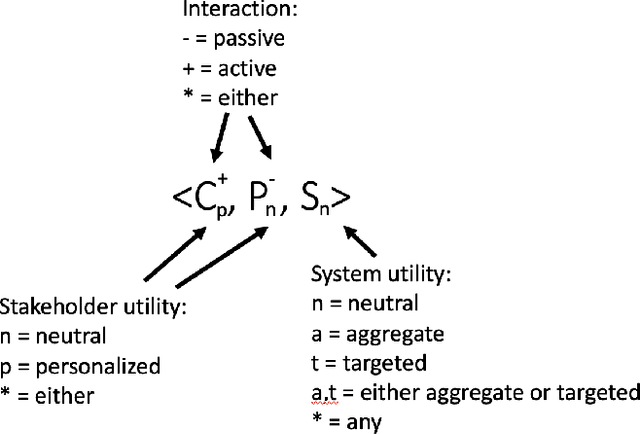
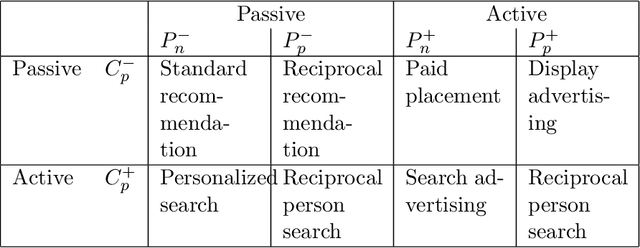
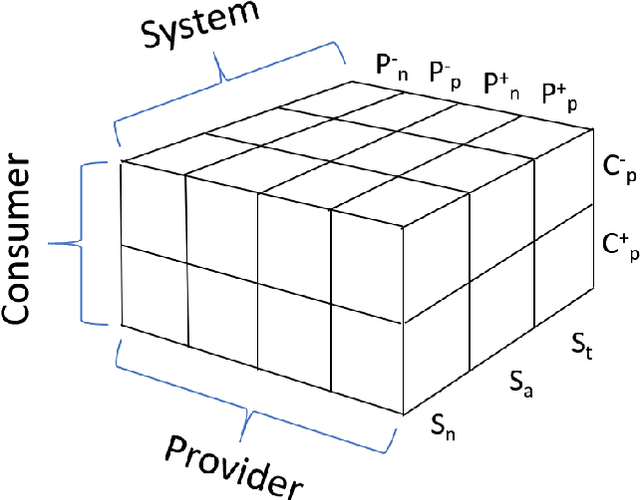
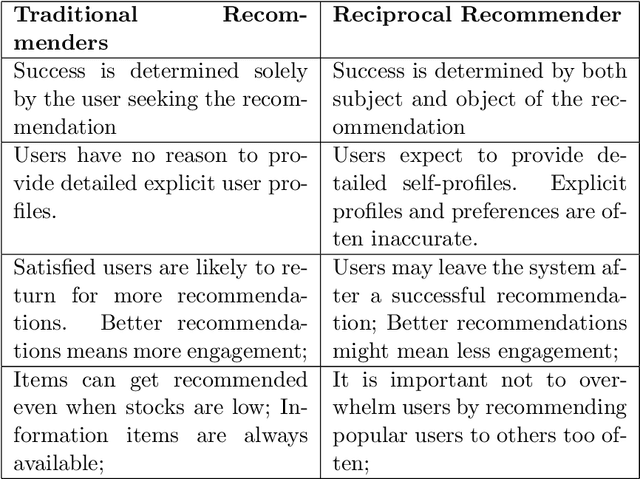
Abstract:Recommender systems are personalized information access applications; they are ubiquitous in today's online environment, and effective at finding items that meet user needs and tastes. As the reach of recommender systems has extended, it has become apparent that the single-minded focus on the user common to academic research has obscured other important aspects of recommendation outcomes. Properties such as fairness, balance, profitability, and reciprocity are not captured by typical metrics for recommender system evaluation. The concept of multistakeholder recommendation has emerged as a unifying framework for describing and understanding recommendation settings where the end user is not the sole focus. This article describes the origins of multistakeholder recommendation, and the landscape of system designs. It provides illustrative examples of current research, as well as outlining open questions and research directions for the field.
Value-Aware Item Weighting for Long-Tail Recommendation
Feb 15, 2018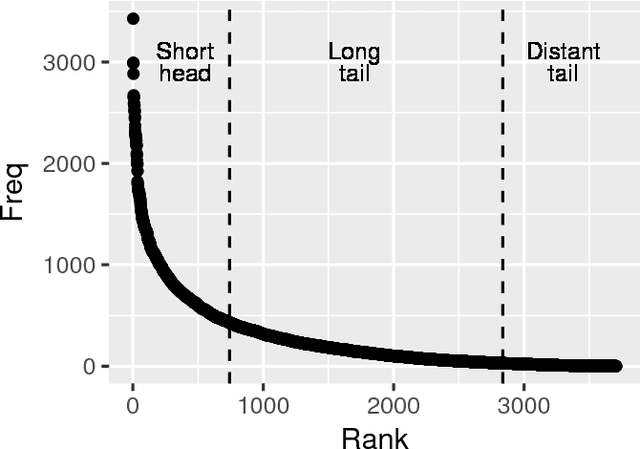
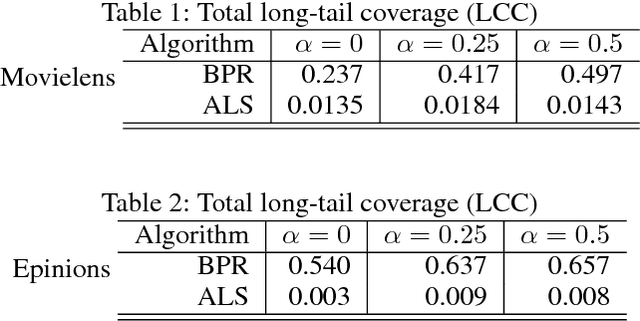
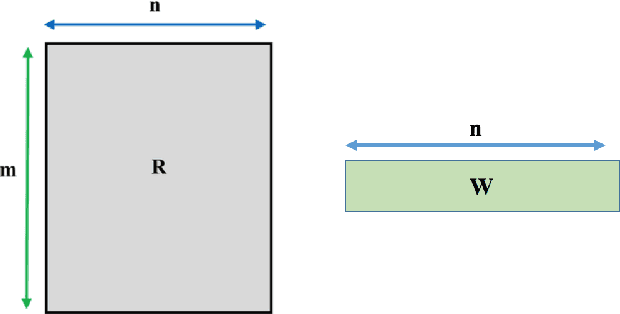
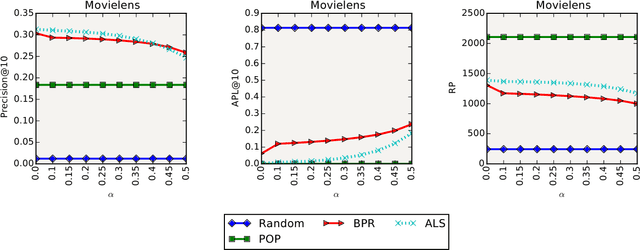
Abstract:Many recommender systems suffer from the popularity bias problem: popular items are being recommended frequently while less popular, niche products, are recommended rarely if not at all. However, those ignored products are exactly the products that businesses need to find customers for and their recommendations would be more beneficial. In this paper, we examine an item weighting approach to improve long-tail recommendation. Our approach works as a simple yet powerful add-on to existing recommendation algorithms for making a tunable trade-off between accuracy and long-tail coverage.
 Add to Chrome
Add to Chrome Add to Firefox
Add to Firefox Add to Edge
Add to Edge